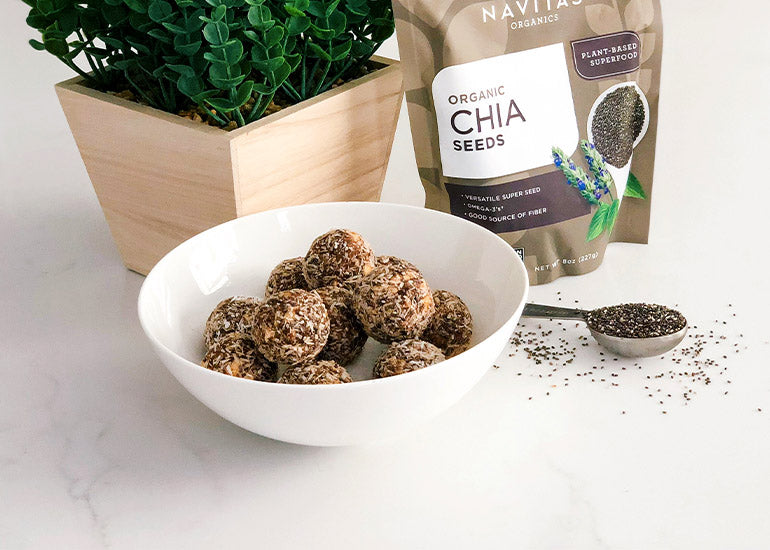Don’t let their tiny size fool you—chia seeds are about as super as a superfood can get! In this blog, we learn all about this powerful plant food: where it grows, why it’s great for the planet, and why it’s great for us.
What are chia seeds?
If you’ve ever cared for a chia pet, you know how easy the plant is to grow! Chia is a member of the mint family, sprouting up happily wherever it’s seeded (unlike most mints, chia does not spread by underground rhizomes and will not take over entire swaths of your garden bed). The seeds sprout quickly, sending up green shoots that eventually branch into fully formed bushes, reaching 3-4 feet tall at maturity. They then send out spikes of small white and purple flowers that gradually wither and die, leaving behind seed heads filled with—you guessed it—chia seeds.
Chia is a natural superstar when it comes to regenerative and organic farming. The plants have deep root systems that grow rapidly, helping to prevent soil erosion and increase soil fertility. They are drought tolerant and pest-resistant, a combination that helps eliminate the issue of water runoff filled with pesticide chemicals, a common result of conventional crop production and contaminant of ground water. Additionally, the flowers attract bees and other pollinators, which support the growth of nearby crops and contribute to overall ecosystem health. Lastly, they’re a friendly plant for use in crop rotation, a cornerstone of regenerative agriculture practices that improves soil health and helps break pest and disease cycles naturally.
Where did chia seeds originate?
Chia is native to south and central America, and its historical use there is well documented. The tiny seeds were a staple in Mayan and Aztec diets, appreciated for the energy and satiety they provided. They were often consumed as a sort of breakfast pudding and were added to water (along with lime juice and a natural sweetener) to provide sustenance on long journeys. The stability of the seeds throughout long term storage and their ease of transport made them especially valuable to these ancient cultures. In fact, they so appreciated the seeds that they often included them in religious ceremonies and offerings.
Why are chia seeds beneficial?
Today, chia seeds have become a staple in the health and wellness industry worldwide. And with good reason: they’re as dense in nutrition as they are full of history!
Omega-3 fatty acids are one of the most touted benefits of chia seeds. This type of fat is essential, meaning we must consume it in our diet because it can’t be made by our bodies. Omega-3 is especially valuable in our foods because most of us get too much of its counterpart, omega-6. When our diet contains far more omega-6 than omega-3, it puts our bodies in a pro-inflammatory state, the foundation condition for many chronic diseases. While most nuts and seeds are high in omega-6 and low in omega-3, chia seeds have the opposite ratio, with over 60% of their fat in omega-3 form. This means that in each ounce, you get 5000mg of omega-3 fatty acids! Compare that to 2440mg of omega-3 in each ounce of salmon.
Equally potent is the mineral content of chia seeds; to say they’re loaded is an understatement! One ounce of the seeds provides 20% of the DV for magnesium, 20% of the DV for phosphorous, 15% of the DV for calcium and 10% of the DV for iron, along with trace amounts of numerous other minerals.
As if that’s not enough, chia seeds are dense with protein, providing 5g of plant-based amino acids in each ounce. They’re also loaded with fiber, supplying 9g—nearly a third of the DV!—per ounce. Additionally, they’re filled with antioxidants like chlorogenic acid, caffeic acid, quercetin and others.
If you haven’t given them a try yet, here’s some good news: chia seeds are incredibly user friendly. They can be turned into chia pudding or chia water, blended into smoothies, stirred into yogurt and oatmeal, incorporated into energy bites and baked goods, or simply sprinkled onto soups, salads, and sandwiches. For more ways to use this superstar superfood, visit our recipe collection here.
)

